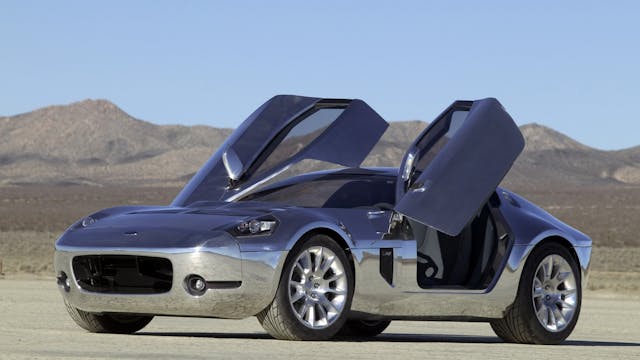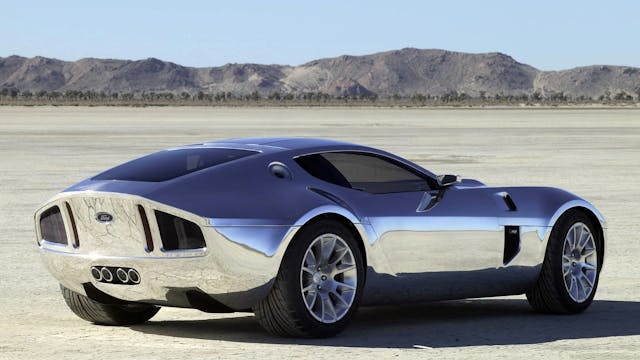Shelby GR-1: The Ford GT sequel that never was
There is a link between Ford’s 2004 Shelby GR-1 concept and Britain’s national speed limit. How so? Well, the original design was inspired by Shelby’s take on AC Cars’ Cobra Coupe, the very model that in 1964 racing driver Jack Sears tested to 185mph on the M1 motorway, making front-page news, and—allegedly—prompting the government to introduce a 70mph limit three years later. That tale never appeared in Ford’s launch material for the GR-1, but with a claimed top speed of 190mph, it would have made a nice tribute to Sears’ bravado.
Trivia aside, in 2004, Ford was already looking at the performance car horizon after the successful launch of its mid-engined GT. With only 4500 GTs planned, a successor was needed and after in-house designer, George Saridakis, penned a 21st-century homage to the ‘60s Shelby Daytona Coupe (the AC’s wilder sibling), Ford’s head of design, J.Mays, commissioned a clay to be produced. When it received a warm reception at that year’s Pebble Beach Concours, Ford’s Advanced Product Creation (APC) team were tasked with developing a fully functional car – and one, maybe, with production potential.

The result was quite breathtaking. Using the mid-engined GT’s chassis as a base, modified to allow front/mid installation of a 597 bhp, 6.4-liter, dry-sump V-10 engine, APC presented a muscular, two-seat fastback design, with a traditional cab-rearward stance, crafted from polished aluminum. Two feet shorter than the GT at just 14.5 ft long, the GR-1 successfully melded cues from the original Shelby without looking overtly retro.
Opening its distinctive McLaren-style “butterfly” doors, drivers were faced with a cleanly-styled part-analogue, part-digital dash, incorporating a ‘TireIQ’ system, which, among other things, recorded cornering G-forces via an accelerometer. Speakers for the GR-1’s sound system were built into the headrest wings of the carbon fiber-shelled seats.
This was no mere styling pastiche, either. With the mighty V-10 installed, taken from Ford’s Modular family of engines, the GR-1 was predicted to hit the aforementioned 190mph top speed, and accelerate from 0-60mph in 3.9 seconds, laying its power down through a limited-slip-differential-equipped six-speed manual transaxle, and sending drive to 19-inch rear wheels shod with 345 x 35 tyres.
Making its first public appearance at the 2005 North American International Auto Show, there was obviously still an interest in seeing the GR-1 through to series production, with Phil Martens, Ford’s group vice president of product creation, making a clear statement about its market position: “Our goal this time around was not to create the ultimate top-speed, high-performance sports car. Really, we intended to strike a better balance of design, capability and usability that might appeal to someone considering a Ferrari 575M Maranello.”

But as was the case with many a promising concept car, the devil was in the detail, and after the GR-1 was subjected to a full feasibility study, significant changes were identified. To be production viable, its 45-inch height needed to be raised, and its wheelbase—which was seven inches shorter than the GT’s on which it was based—needed to be lengthened, too. The GR-1 was not a light car, either, with the concept weighing in at 3900 lb. Ford’s target production weight was 3500 lb, and consideration was given to replacing the GR-1’s V-10 with a V-8 to achieve that goal.
In the end, though, Ford’s production dreams for the GR-1 wouldn’t pan out. While the changes needed didn’t present insurmountable hurdles for the car’s development team, Ford was starting to get its fingers burned with GT sales. After an initial rush of orders when the car launched in 2004, demand had dropped significantly two years later. Faced with the prospect of only selling 4000 GTs from the originally-conceived 4500-car run, Ford’s accountants could only see the same scenario playing out with a production GR-1, and slammed on the brakes.

That isn’t quite where the story ends, though. There was still a lot of love for the GR-1 in enthusiast circles, and one person could still see its potential in a more limited market. Lance Stander, CEO of California-based Superformance—distributors of low-volume, high-end recreations, such as the Corvette Grand Sport, Cobra, GT40, and Shelby Daytona Coupe—sought to reach an agreement with Ford and Shelby America to purchase the rights to produce a modified version of the GR-1. After many years, they succeeded, and in 2019 Superformance announced that it would be taking orders for its own Shelby GR-1, with the choice of either an aluminum or carbon fiber body, and an output of 750bhp from a Ford V-ok8 engine. The predicted cost: $250,000.
Unfortunately, the federal government recently halted implementation of the regulation which would have given Superformance exemption from the safety and labelling standards required to build the Shelby GR-1 in low volumes. But we still live in hope…
***
Check out the Hagerty Media homepage so you don’t miss a single story, or better yet, bookmark it. To get our best stories delivered right to your inbox, subscribe to our newsletters.
Via Hagerty UK





Very Nice Silver Hot wheels Car.
This is what the new Z car should look like instead of a rolly polly bug with that big fat nose.
You got that right!
I would have mortgaged my property to own one of those. I’m not sure my wife would have gone along with that,but,like they say”A Dollar And A Dream”.
Looks like Ford “borrowed” a bit from Pantera!!
And Fisker? https://en.wikipedia.org/wiki/File:Fisker_Karma_2.jpg
Would like to hear from someone with VP-level or higher experience at a major manufacturer comment on the phrase “the accountants killed it.”
You hear this all the time when an enthusiast-centered concept is not brought to series production. If accountants controlled every product planning decision, how do you explain cars like Chevy’s Bolt, with reports claiming that GM loses thousands of dollars on each one?
Maybe “The accountants killed it” is a nice way of protecting the identity of the executive(s) who truly had decision-making authority, or is code for “the car was not financially viable” – which is a perfectly understandable business decision – but vilifying the accountants doesn’t seem to do justice to the story.
Perhaps the automotive press should start featuring the accountants in stories where they’ve green-lighted enthusiast cars.
Good point. Well stated. Just about anything can be pinned on the bean counters.
I seem to recall that it was more to do with the accountant’s than engineers or product planners that introduced all that front-wheel drive crap that american car companies gave us back in the 80’s.
So if Superformance couldn’t get it into the US as a production car, maybe Factory Five could as a kit? I’m in if they do!
I
I’m on board also there goes the farm for another car oppps Automobile!
Don’t tell my precious wife that this GR-1 is my other love… but selling her is the only way I could ever afford it! What a conundrum!
I own a Shelby Cobra MKIII…that was my dream car…I now have a new dream car!
Absolute beauty and full of testerone which is now in short supply. It’s testicles must be tucked away.
Very cool car. Wish it had been made.
That is an Amazing piece of engineering,
Honestly, this has to be the sexest GT ever made!
The accountants that killed this project must have muss for brains and use scooters to get to work.
Ford should never allow cubicle workers decide the future of the most classic racer Ford has ever had in its stable. GTs Forever!
As a retired accountant, I feel obligated to point out it was government bureaucracy that killed the project and not us bean counters. Beautiful car though.
Shelby’s “take” on the AC Coupe?!? Revisionist history at its finest. CSX2287–the first Daytona Coupe–was completed in late 1963 and raced at Daytona in February 1964. The bodywork for the A98 wasn’t finished until a couple of weeks before Le Mans in June 1964. By then the Daytona had already raced at Daytona and Sebring. To suggest that the Daytona was a “take” on the A98–i.e., a subsequent interpretation of it–is disingenuous.
Bob….Thanks for correcting this bit of ancient history! CSX 2287, the first Daytona Cobra Coupe, was completed and ran at Daytona on February 16th, 1964, long before the first GT40s or the AC Coupe were even on wheels!
What a difference 20 years makes. This car has lines that are viscerally appealing, unlike the Origami School of Design that has made its mark on many of today’s cars. I hope someone builds it; I don’t care who. I’m 72 and could die a happy gearhead if this was the last car I owned.